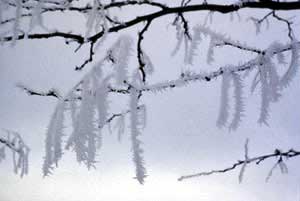 August 26, 2004
In a paper published in the August 20 online edition of Climate Dynamics, NCAR scientists Gerald Meehl, Claudia Tebaldi, and Doug Nychka examine the factors that have led to a reduction in frost days in many areas over the last 50 years. The authors then use the Parallel Climate Model, developed by NCAR and the U.S. Department of Energy, to simulate day-to-day temperature changes across the globe for the years 2080 to 2099. NCAR's primary sponsor, the National Science Foundation, and the DOE funded the study, with additional support from NCAR's Weather and Climate Impact Assessment Initiative. Over the last half-century, many weather stations across the western United States reported a decrease of 10 or more frost days per year, mostly the result of warmer conditions in springtime. Little change in frost-day frequency has been reported across the upper Midwest and Northeast. Until now, most modeling studies of future climate change have focused on average temperatures rather than day-to-day variations, says Meehl. "For many years, a lot of the models didn't even have diurnal [24-hour] cycles," Meehl says. With increased computer power and more complex software, scientists can now simulate and study changes in potential day-to-day weather events far into the future. This study is the first to examine trends in frost days using a global climate model. Meehl and colleagues found the frost-day trends over the last 50 years intensifying during the next century. Nearly all of the United States and Canada show losses in frost days in 2080-2099 compared to 1961-1990. "In general, there is a gradient from west to east across the continent, with greater decreases in frost days in the western regions," says Meehl. The biggest decrease is from the Great Plains westward, where the model produces more than 20 fewer frost days in a typical year by 2080-2099. More than 40 fewer frost days per year are projected along and near the Pacific coast from Washington State north into British Columbia. The factors at work The cause of this pattern, according to the authors, is a shift in atmospheric circulation.
Although the model warms polar regions the most (as measured by average daily minimum temperatures), these areas do not show the largest decrease in frost days. The difference is in part because winter nights are so cold at high latitudes that even a century of warming fails to bring the averages above freezing. Changes in soil moisture and cloud cover can also affect overnight low temperatures. However, the changes in atmospheric pressure and circulation were the dominant factors in producing the frost-day reductions for all locations the authors studied. Implications for agriculture Frost days are obviously related to the growing season, but a reduction in frost days does not necessarily mean a longer season for crops. For example, the average dates for the first and last freeze might not change even if there are fewer intervening freezes. The authors compared the 20802099 model results to 1961-1990 data for one common measure of the growing season: the number of days between the first six-day spring stretch with average daily temperatures above 41°F and the first six-day autumn period with averages below 41°F. Although the length of the growing season increases in all regions examined, the authors found only a weak statistical relationship between this result and the changes in frost days. "This tells us that other factors, in addition to frost days, contribute to the length of the growing season," says Meehl. The NCAR team plans to examine growing seasons in more detail in a future study. The frost-day study, as well
as a related effort examining heat
waves, was produced in preparation for the next assessment
by the Intergovernmental Panel on Climate Change, which is expected
in 2007.
Source of News Release & Photo:
|
||
